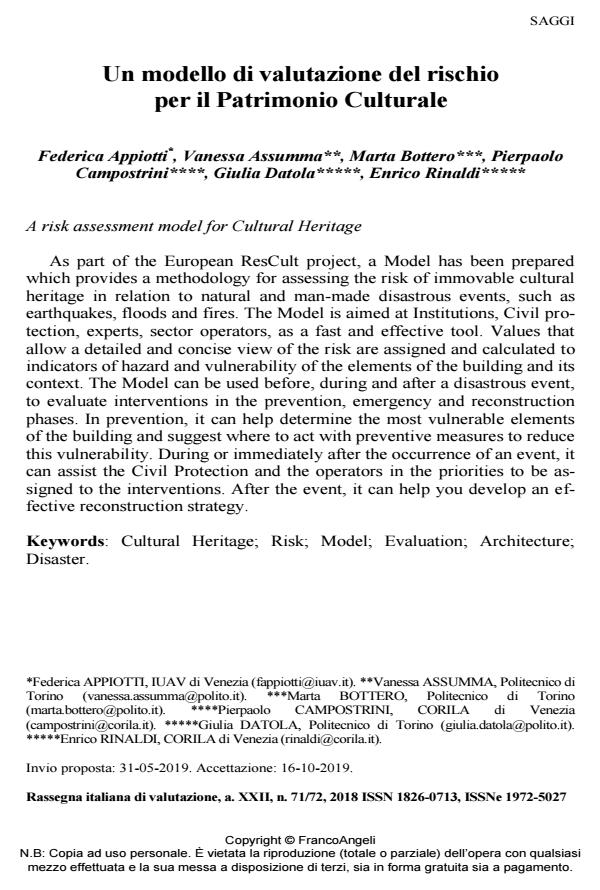Un modello di valutazione del rischio per il Patrimonio Culturale
Journal title RIV Rassegna Italiana di Valutazione
Author/s Federica Appiotti, Vanessa Assumma, Marta Bottero, Pierpaolo Campostrini, Giulia Datola, Enrico Rinaldi
Publishing Year 2019 Issue 2018/71-72
Language Italian Pages 28 P. 121-148 File size 1017 KB
DOI 10.3280/RIV2018-071007
DOI is like a bar code for intellectual property: to have more infomation
click here
Below, you can see the article first page
If you want to buy this article in PDF format, you can do it, following the instructions to buy download credits

FrancoAngeli is member of Publishers International Linking Association, Inc (PILA), a not-for-profit association which run the CrossRef service enabling links to and from online scholarly content.
As part of the European ResCult project, a Model has been prepared which provides a methodology for assessing the risk of immovable cultural heritage in relation to natural and man-made disastrous events, such as earthquakes, floods and fires. The Model is aimed at Institutions, Civil protection, experts, sector operators, as a fast and effective tool. Values that allow a detailed and concise view of the risk are assigned and calculated to indicators of hazard and vulnerability of the elements of the building and its context. The Model can be used before, during and after a disastrous event, to evaluate interventions in the prevention, emergency and reconstruction phases. In prevention, it can help determine the most vulnerable elements of the building and suggest where to act with preventive measures to reduce this vulnerability. During or immediately after the occurrence of an event, it can assist the Civil Protection and the operators in the priorities to be assigned to the interventions. After the event, it can help you develop an effective reconstruction strategy.
Keywords: Cultural Heritage; Risk; Model; Evaluation; Architecture; Disaster.
- Documenting cultural heritage in an INSPIRE-based 3D GIS for risk and vulnerability analysis Elisabetta Colucci, Francesca Matrone, Francesca Noardo, Vanessa Assumma, Giulia Datola, Federica Appiotti, Marta Bottero, Filiberto Chiabrando, Patrizia Lombardi, Massimo Migliorini, Enrico Rinaldi, Antonia Spanò, Andrea Lingua, in Journal of Cultural Heritage Management and Sustainable Development /2024 pp.205
DOI: 10.1108/JCHMSD-04-2021-0068 - Masonry Vaults Reinforcement with FRCM-PBO: Conservative and Structural Issues Lia Ferrari, Luca Melegari, in Key Engineering Materials /2022 pp.475
DOI: 10.4028/p-x7hd00 - New Metropolitan Perspectives Giulia Datola, Vanessa Assumma, Marta Bottero, pp.2565 (ISBN:978-3-031-06824-9)
- Modeling and Design of the Restoration and Seismic Strengthening of the Sanctuary of Santa Maria Delle Grazie at Fornò under New Italian Rules NTC 2018 Alberto Custodi, Nicola Santopuoli, in Key Engineering Materials /2019 pp.650
DOI: 10.4028/www.scientific.net/KEM.817.650
Federica Appiotti, Vanessa Assumma, Marta Bottero, Pierpaolo Campostrini, Giulia Datola, Enrico Rinaldi, Un modello di valutazione del rischio per il Patrimonio Culturale in "RIV Rassegna Italiana di Valutazione" 71-72/2018, pp 121-148, DOI: 10.3280/RIV2018-071007